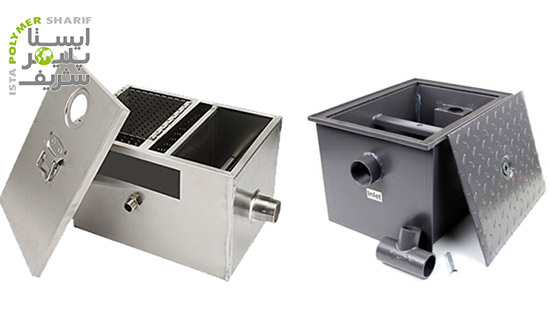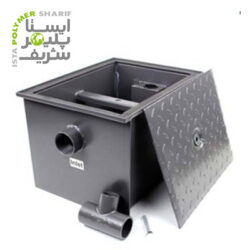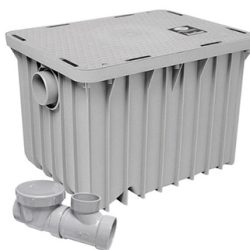Every restaurant has a grease trap in its sewage system, which is responsible for separating fats, oils, and grease from the water flow. A restaurant grease trap is an essential component that ensures the smooth operation of the kitchen. Typically, this device is discreetly placed under sinks to remain out of sight. If you’re a restaurant owner considering purchasing a grease trap, it’s important to familiarize yourself with this equipment.
What is a Restaurant Grease Trap?
This device prevents fats, oils, and grease (FOG) from clogging sewer lines and entering water sources. Usually installed in kitchens near sinks or dishwashers, the grease trap consists of two compartments. It operates by allowing fats to cool at room temperature, causing them to solidify and float to the top. Water flows from the first compartment to the second via pipes at the bottom, while fats remain on the surface.
The grease trap is designed to hold a specific amount of waste but requires periodic cleaning. Improper maintenance can lead to fats clogging the pipes. Essentially, proactive maintenance is crucial to prevent pipe blockages.
Advantages
Installing a grease trap is ideal for preventing fats from entering your sewage system. They capture fats for proper disposal, providing several benefits for your kitchen. The three main advantages of installing a grease trap include:
Preventing Fat Entry
Grease traps prevent fats from entering main water lines. Fats, oils, and grease are common waste products from commercial kitchens that float to the top of the device, while water flows down and is discharged into municipal plumbing.
Environmental Compatibility
Installing this device in your kitchen prevents fats from entering sewage and causing issues in water treatment processes. Instead of allowing fats and oils to enter natural waterways, they can be recycled in specialized treatment facilities for agricultural use.
Cost-Effectiveness
Installing a grease trap helps prevent costly repairs to your plumbing and sewage system. Improper disposal of fats from your kitchen may lead to sewage blockages, necessitating frequent cleaning or even replacement of your plumbing system.
Features
Constructed primarily from metal, grease traps are positioned between the kitchen sink and the main sewage system. They are typically designed to fit discreetly at the kitchen sink outlet. They can be installed both indoors and outdoors, with indoor models requiring more frequent cleaning compared to outdoor models, which do not occupy indoor space.
Cleaning the device can be done manually, and performing a weekly inspection is recommended as the best maintenance practice. Neglecting these inspections can lead to the device becoming full, causing it to fail to retain fats and oils and potentially creating unpleasant odors in the kitchen.
Key features of this device include:
- High efficiency in fat and oil removal
- Quick installation and setup
- Capability to remove suspended solids and settleable particles from sewage
- Ability to store sludge and fats
- Suitable weight and ease of handling and installation
- No need for on-site construction operations
- High durability and long service life
- Resistance to corrosion
- Ease of operation and disposal of fats and sludge
- Inspection ports for regular checks
Important Considerations for Purchase
When purchasing, consider the following crucial factors:
Type
Various types of grease traps are available, each with its own advantages and limitations. Hydro-mechanical grease traps are compact and cost-effective but require frequent cleaning. Gravity models made of materials like steel, plastic, or fiberglass are practical but need replacement approximately every 15 years. While automatic models are expensive, they have minimal maintenance and cleaning costs.
Performance and Space
Assess the equipment’s performance and the amount of space it occupies. Since grease traps can be installed inside or outside buildings, restaurants in densely populated areas should consider an indoor grease trap. Measure your indoor space to determine if your kitchen has enough room for one or more devices.
Size and Capacity
The size of your business or the amount of kitchen activity can influence your choice of the right device. Smaller restaurant grease traps have less capacity for waste management and therefore require more frequent cleaning. Larger models require less cleaning.
Maintenance
When selecting a restaurant grease trap, consider its maintenance and cleaning requirements. Some systems are easy to clean, while others require specialized skills for maintenance. Choosing an easy-to-clean device can save you costs in the long run.
Final Thoughts
While grease traps are used to collect solid fats, oils, and grease, regular maintenance and cleaning are necessary to enhance their performance. When these devices become filled with solid food materials and fatty debris, their efficiency significantly decreases. Ultimately, this issue can lead to sewer pipe clogs and subsequent costs. Several factors, such as device type, amount of fat produced, fat type, plumbing system quality, etc., influence the effectiveness of these devices. It’s essential to invest in a quality restaurant grease trap as you heavily rely on this equipment.



